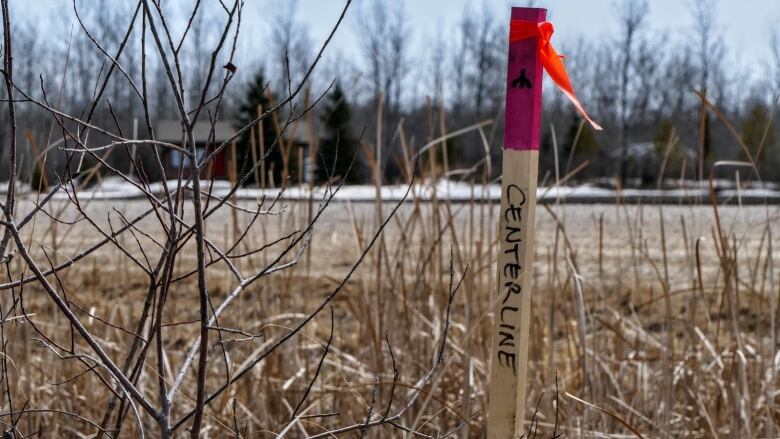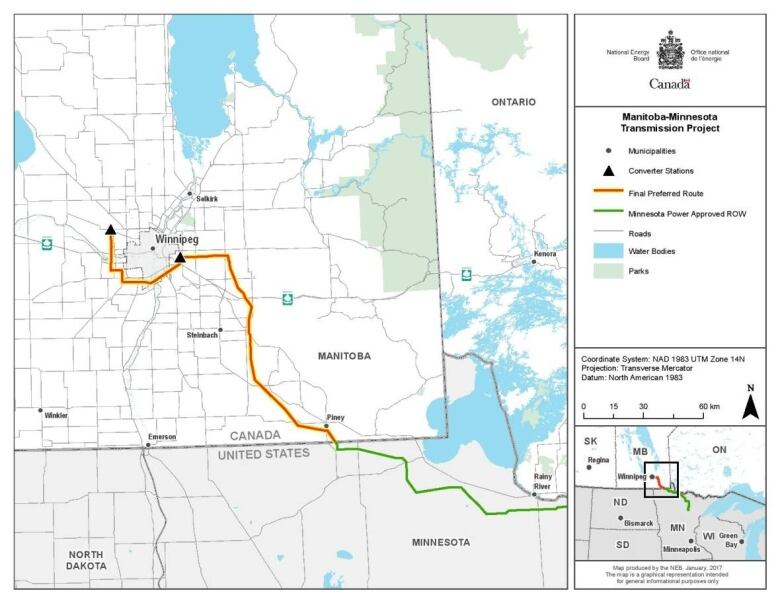Property owner won't sell land to Hydro 'until last dog is hung'
Hydro faces hurdles to get transmission line built by 2020 deadline

For several decades Ed Rak has been growing berries, taking walks in the woods and hunting deer every fall on his 37-and-a-halfacres in the RM of Tache.
A couple of weeks ago Rak saw a Manitoba Hydro employee surveying a piece of land nearby and banging stakes into the ground. It was physical sign that the massive Manitoba-Minnesota transmission line was one step closer to Rak's small bit of prairie paradise.
Beyond a couple of old photographs, the land is literally the only connection Rak has to his father, who died in 1941 when he was 10-months old.
"It's a sentimental piece of property because it was my dad's. First piece of land [he purchased] when came from Poland," Rak said.
The place is more cottage than home. A two-bedroom cabin sits just off the road, with sheds for hanging deer and an outhouse nearby. There are signs of a recent snack on the table in the living room and a sturdy wood stove at the ready for cold nights. Rak lives a 20-minute drive away in Dugald and is at the cabin every chance he gets.

A Hydro representative came to his house last year offering $63,000 for an easement on the property to build the line, but he isn't interested.
Rak calls it a "bribe."
"When he came to my house and offered me that money he said if I didn't sign, I would be expropriated, and I wouldn't get as much, which I think is bullshit," Rak said. " I told him he could leave and said I wouldn't sign until the last dog was hung."
Beyond the sentimental tie to the land through a dad he didn't know and the strong possibility a grandson would like the land, the retired truck driver says themunicipality allows property in the area to be divided into five acre lots, making subdivision more valuable than the offer Hydro is making.
But Rak believes the massive towers and humming lines would dash any interest from people looking to buy lots. He says giving an easement to Hydro is the worst choice.
"What is the property good to me? Nothing. Nobody wants to live under a power line. Especially because [it is] a big high-voltage line" Rak said.
Though he is loath to let go of the property, at the end of the day Rak would prefer a clean break than trying to co-exist with the line.
"I don't really want to sell it, but if push-comes-to-shove and they are putting the line through, they might as well buy me out because it is actually worthless to me," Rak says.
According to Hydro the company has learned from previous land assembly efforts. The utility now offers 150 per cent of the market value of a property for the easement with a 50 per cent upfront payment and a pledge to be more sensitive to concerns by having a "dedicated landowner liaison" assigned to each landowner.
Hydro also offers payments for damage to the land and extra payments for property that is being used for agriculture.
Rak, who is a member of the Southeast Stakeholders Coalition ( a group of landowners fighting Hydro on the route of the line), isn't confident American customers will remain hungry for Canadian electricity long into the future.
"It's just a waste of time and money because of the way things go with solar electricity. I went to Europe last summer, in Germany especially, they have solar outfits, like big fields full. So they are producing their own power. And that's bound to happen in the States. They have enough of these towers now. Windmills," Rak said.
A tale of two lines
The massively over-budget Keeyask dam project is the northern-most piece of a Manitoba Hydro puzzle that stretches deep into the United States. The next step is the also over-budget and essentially complete BiPole III transmission line.
Still on the Canadian side of the border, Hydro has been planning its Manitoba-Minnesota Transmission project (MMTP) for years and had expected to be through regulatory hurdles and cutting the path for the 213 kilometre line by 2017.
It has been a far smoother sail south of the border.

According to MP-Allete senior vice president Pat Mullen, the construction is likely to come in close to the high end of that estimate.
The steady pace of the construction can be tracked on Minnesota Power Great Northern Transmission linewebsite.
Manitoba Hydro, its Canadian customers and potentially the Manitoba taxpayer will cover 72.7 per cent of the American project. Converting the dollar, Hydro's portion of the construction could costbetween $326 million and $451 million for the line.
Manitoba Hydroisresponsible for 33per cent of the operations and maintenance of the line "at anytime into the future."
At one point Manitoba Hydro owned just under 50 per cent of the GreatNorthern transmission line, but negotiations between the two utilities concluded in April 2016 leaving Minnesota Power as sole owner.
The American power company is well along in constructing its portion of the transmission line. Minnesota Power's Mullen says crews had a "good winter," because the cold weather froze marshy areas of the route, allowing for better access.
The company has cleared substantial parts of the right-of-way and started installing foundations for the towers for the line and has spent approximately $200 million of its budget so far.
The Americans are on-time and on-budget with the southern portion of the line.
Meanwhile back in Canada
Despite not having cut down a tree or erected a tower, Hydro's estimate to build the Canadian side of the line has risen from an original cost of $350 million (Canadian) to $453 million (Canadian).
Hydro filed its application for review by the National Energy Board in December 2016 and expected to have approval by the end of August 2017 and start construction on the line in mid-December, in order to have electricity flowing south by May or June 2020.
- $453M Manitoba Hydro line to Minnesota could face delay after energy board recommendation
- Manitoba Hydro line to Minnesota to go through public hearing process
The federal regulatory process has, however, gotten more complicated.
The NEB decided in December to review Hydro's MMTP application with public hearings, a more labour-intensive process.
The Southeast Stakeholders Coalition sought and lost a bid to have the hearings adjourned because of the recent mass resignation of Hydro's board and the state of the crown corporation's finances.
Sagkeeng First Nation also wrote to the NEB calling for a postponement, asking for financial information about Hydro to determine whether the company can build the line and adequately compensate Indigenous people affected by construction.
Sagkeeng First Nation has intervenor status in thepublic hearings.
Peguis First Nation has written to the NEB seeking assurances consultation with Indigenous groups is "at the high end" and be provided with adequate resources to make presentations to the Board.
Hydro has not provided CBC News with the status of land assembly for the transmission project.
Despite the possibility of a more complicated and potentially longer regulatory process, Manitoba Hydro's U.S. partner isn't worried
Minnesota Power 'comfortable and confident'
"We have a really great working relationship with Manitoba Hydro. We have for decades... and they have given us an indication that they will be able to work through this and they will be relatively on time," said Minnesota Power's Mullen.
Confidence in the partnership with Hydro is so high Mullen says there hasn't been much research into major delays on the Canadian portion of the line because "we don't know that we need to.
"As we take the lead from Manitoba Hydro I think we are getting indications that they think they will be able to work through this appropriately," Mullen said.
Mullen was not aware of any penalties that would accrue to Hydro ifit couldn't complete the northern part of the line on time, saying "we will work that out together and it will be fine."
CBC News asked Manitoba Hydro what penalties would result from the not meeting the mid-2020 deadline for completion and was told that information was "confidential/contractual" and could not be released.
In response to questions about whether Hydro could make its completion deadline and start sending power south, in an email, Hydro spokesperson Bruce Owen said the following:
"The anticipated in-service date for MMTP is mid-2020."
The treasure at the end of the combined567 kilometres of high-power line is over $4.3 billion in long-term export contracts tied to electricity generated at Keeyask and sold to customers in Minnesota and Wisconsin.













_(720p).jpg)


 OFFICIAL HD MUSIC VIDEO.jpg)
.jpg)



























































































